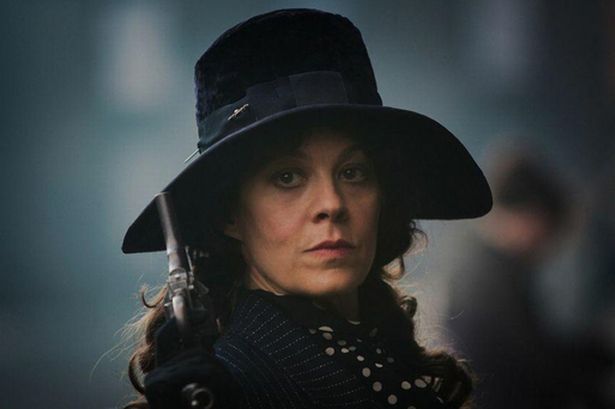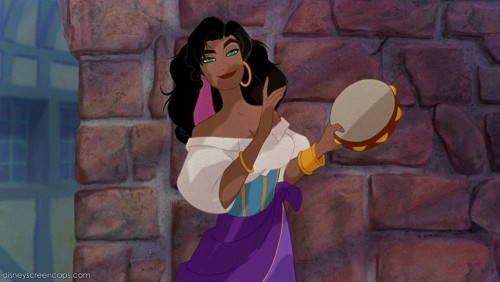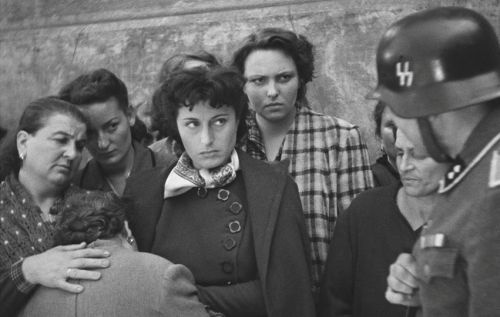Written by Jackson Adler | Spoilers ahead.
[Trigger warning: rape and sexual assault; contains harsh language]
Despite (small) recent improvements, there is still a lack of well-written female characters on our screens. Especially anti-heroines. And female characters who are middle-aged. And characters who are working class. And of a religious minority. And are of ethnically marginalized groups. And in positions of power. And whose stories of physical and sexual oppression are more than plot devices to further the motivations of male leads.
Meet Polly Gray from the BBC series Peaky Blinders.
Polly (Helen McCrory) is working class, Romanichal (a British subgroup of Romany) and Irish, devout Catholic, and a middle-aged female in 1919 through 1920s Birmingham, England. She is a loving mother and aunt, as well as the treasurer for and semi-retired leader of the Peaky Blinders, who are “illegal bookmakers, racketeers, and sometimes gangsters,” and who are led by her family, the Shelbys. In order to survive, Polly had to become “hard as nails,” as her actress Helen McCrory describes her. Together with her nephew Thomas Shelby (played by Cillian Murphy), Polly fights to bring safety, respectability, and power to her family through both legal and illegal activity. As anti-heroine and anti-hero, Polly and Thomas head a family of “good people who do bad things for a good reason.”
Polly is female character who is complex and multi-faceted in ways that are still extremely rare but much needed in our culture; however, her story is often undermined by those whose responsibility it is to help tell it, especially with regard to her being Romanichal. Roma leading characters are still rare in media, and when they are depicted, they are often heavily stereotyped. Though Peaky Blinders and Hemlock Grove feature Roma families made up of complex and well-developed characters, it must be pointed out that Peaky Blinders is about criminals and Hemlock Grove is about fantasy and mysticism – two of the most prevalent and harmful stereotypes of Roma. It is emphasized in Peaky Blinders, though, that the Shelbys resort to criminality only because they see it as the only way to bring themselves out of poverty and into “respectability,” with their goal to eventually do only legal work. There are also many criminal or villainous characters in the show who are not Roma. However, it is odd and problematic that the two current TV series that feature Roma characters also feature them as stereotypically criminal and mystic, stereotypes which contribute to the “othering,” and therefore oppression, of Roma.
Polly Gray realistically faces extreme discrimination directed at her Romanichal heritage from characters within the show, and yet the creative team behind Peaky Blinders is often also disrespectful of that identity. She and the other Romanichal characters (of which there are many) are whitewashed via the casting of non-Roma and white actors. Helen McCrory is Scottish and Welsh, and Cillian Murphy is Irish. Though there are certainly white-passing Roma, they are a people of color who originated in Northeastern India and Northwestern Pakistan. Not only is this compelling female character of color whitewashed, but Polly and her family are called the ethnic slur “Gypsy” frequently both within the series and without. It is troubling that the cast and creative team, especially creator and writer Steven Knight, would refer to this highly oppressed people (whom they are supposedly working to represent and empower) as an ethnic slur.
This is all the more troubling and downright disturbing as the systematic oppressions that Polly faces, especially with regard to the intersection of her gender and ethnicity, are still wielded today. Polly’s children were kidnapped from her by law enforcement, like many other Roma children were and are from their parents. This contributed to the early death of her daughter, Anna, who is never depicted in the series. Once Polly’s son, Michael (played by Finn Cole), grows up, he leaves the family to whom he was forcibly relocated and finds her. She struggles to reclaim her role as his mother and, as a single mother, to provide the sort of life she wishes to give him. Due to the prosperity of the family business, much of it now legal, Polly and Michael live in a spacious house with a live-in maid and in a “respectable” neighborhood. However, no amount of wealth or respectability politics prevents law enforcement from targeting the Grays and the Shelbys due to their ethnicity. Though there are other contributing factors, it is still a racialized scene when law enforcement arrests Michael on a trumped up charge and takes him from Polly again. Michael, who is only 17, is then tortured by law enforcement until he confesses to the crime he didn’t commit. While Michael was arrested in the early 1920s, there is still a severe over-representation of Roma in UK prisons due to discrimination. One out of every 20 prisoners identify as “Gyspy, Romani or [Irish] Traveler,” and over-representation is even higher in youth prison facilities. This is despite, as of 2013, Roma numbering only about 200,000 in the UK, out of a total population of about 64 million.
A leader of law enforcement, Major (formerly Inspector) Campbell (played by Sam Neill), tells Polly that he won’t allow Michael to be released from jail unless Polly lets Campbell rape her and show that she is “small and weak” compared to him. For the sake of her son, whom she knows is being tortured, Polly stops fighting Campbell and plays along with what he wants. Campbell enforces the system’s and his own biases against the intersectional identities of Polly, as he says to her while raping her “You think you’re so respectable with your son and your house. But I know what you are, you Gypsy Fenion slut.” (Note: “Fenion” is a derogatory word for Catholics, and Irish Catholics in particular, although it has other uses.) Rape is a very real weapon used against women, especially women of color, including women who are Roma.
Upon my first viewing of the series, I thought that, unlike how rape is often used in TV and film, Polly is not raped to further the leading male character’s (Thomas’) plotline and character development. After a few more viewings, I realized that’s (sadly) not entirely true, even though this rape storyline is still much more focused on the female survivor than those of other shows. Polly comforts herself after the rape by going out for six whiskeys, going home and taking a bath, and most importantly by talking with her niece Ada (played by Sophie Rundle), with whom she has a very close relationship. Ada is also a fellow survivor of sexual assault. Like Polly, her husband has died and she is now a single mother to a young son for whom she wants to provide and to protect. After Michael is released from jail, Polly makes certain that she, not Thomas, is the one to confront Campbell and avenge herself and her son. She then goes home and shares a warm embrace with Ada. Seen this way, the story is focused on women, especially women of color, and how they support each other and their families while asserting their own autonomy against severe oppression.
Polly with Campbell’s blood on her dress, walking away from shooting him.
However, the rape storyline also gives attention to the leading male characters, and the story is made to be largely about Thomas. Campbell raped Polly largely in an attempt to shame and emasculate Thomas. Thomas responds by sleeping with a former love interest of Campbell’s, and succeeds in angering Campbell by doing so. Also, Thomas does confront Campbell, he just isn’t the one to pull the trigger. As problematic as this part of the rape storyline is, however, it is also important to note that Campbell’s and Thomas’ sexism (by treating women as objects and possessions that can be stolen) backfires on both of them. Though Campbell’s main goal in raping Polly was to attack Thomas, it is Polly who is the one to ultimately “finish” him, saying, “This time ‘small and weak’ has a gun” and reminding him, “Don’t fuck with the Peaky Blinders.” Meanwhile, though one of the main reasons Thomas sleeps with the character Grace Burgess (played by Annabelle Wallis) is to use her to anger Campbell, after she and Thomas have sex, Grace reveals that she was, in part, just using Thomas in the hopes of becoming pregnant (as her husband is infertile), and (at least at first) Thomas is offended that she didn’t inform him of this plan. Both Campbell and Thomas are reminded that women are thinking and feeling human beings with their own motivations capable of self-assertion.
This is far from the only time that the male characters in Peaky Blinders are called out on their sexism, and it is usually Polly who does it. Polly not only fights sexism from her enemies, but also from the men she loves and trusts most. In the first episode of the series, when at a family meeting in regard to the business, Thomas condescendingly states that he has nothing more to say about the goings-on of the company that is “any of women’s business.” Polly then reminds him that she ran “the business” while he and two of his brothers were fighting in WWI, meaning that “this whole business was women’s business,” and demands that he inform her of what he is hiding. It should be noted that Polly only gave up direct leadership of the gang because she felt it was the birthright of her nephews. Though Thomas improves in how he sees and treats women, and even claims that he and the family’s “modern enterprise” believe in “equal rights for women,” Polly justifiably calls him out on his hypocrisy, pointing out that he neither “listens to” nor trusts women as much as men.
Of Polly’s adult nephews, Thomas still respects Polly the most and is closest to her despite his sexism. Thomas’ two oldest brothers Arthur (played by Paul Anderson) and John (played by Joe Cole) still respect Polly, but when they are being most respectful to her, they (especially Arthur, the oldest nephew) refer to her as the male-sounding name “Pol” (as in “Paul”) or “Aunt Pol.” This emphasizes that they see power and strength as inherently masculine, despite Polly constantly reminding them that she is a woman and that they should all respect her and other women better. Though John respects Polly more than Arthur does, and is on the whole kinder to women than even Thomas, he does not see women as equal. When Thomas encourages John’s wife Esmé (of the Romanichal Lee family and played by Aimee-Ffion Edwards) to speak at a family meeting, John initially protests, says that as “the head of” his family that he will “speak for” her. Though Thomas makes certain that Esmé speaks, he quickly dismisses what she has to say, for which Polly criticizes him. Polly even experiences sexism from her son, who victim-blames her to her face after Campbell rapes her, despite that he was only freed from being tortured in jail because of it. Thomas became more accepting and respectful toward women because of Polly’s influence, while Michael was kidnapped from his mother’s influence at the age of three. In this way, the systemic oppressions on the Shelby-Gray family not only directly hurt them, but indirectly hurt them by turning them on each other.
Michael walking away from Polly after victim-blaming her.
Though at times problematic, Polly’s story and interactions with other characters is one of a powerful and complex woman who supports and encourages respect for other women. While she herself is imperfect and not free from bias, and participates in the slutshaming of sex worker-turned-secretary Lizzie Stark (played by Natasha O’Keeffe), she overall supports women (especially fellow Romanichal women such as Esmé and Ada) in both the workplace, such as by demanding they have a say in how the business is run, and the home, such as by helping Ada with her new baby. The story does not mock her for her assertiveness and for her support of women’s equality, even though male characters often do. Though Polly is whitewashed, and is not the leading character (rarely being featured in the series’ posters and publicity photos, and is referred to often by an ethnic slur, Polly’s role in Peaky Blinders is still refreshing when compared to how other TV series depict women and their storylines. Hopefully in the coming third season of the show, Steven Knight will continue to and even improve in how he writes Polly and how she contributes to the overall narrative of the story. One can also only hope that Peaky Blinders will inspire other series to write multi-faceted women and Roma.













